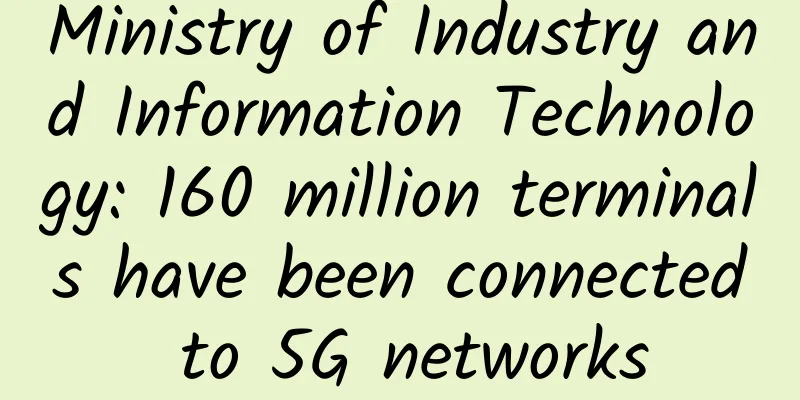Ministry of Industry and Information Technology: 160 million terminals have been connected to 5G networks

|
On October 22, at a press conference held by the State Council Information Office today, Wen Ku, director of the Information and Communications Development Department of the Ministry of Industry and Information Technology, said that the cumulative number of 5G base stations put into operation has reached 690,000, and more than 500,000 new 5G base stations have been built this year, completing the annual target of 500,000 ahead of schedule, and basically achieving 5G coverage at the prefecture and city level. From January to September this year, the shipment of 5G mobile phones was about 108 million units, and 160 million terminals have been connected to the 5G network.
Wen Ku pointed out that 5G has entered a critical stage of development, and application promotion is the focus of current work. In the next step, we will continue to make steady progress, fully mobilize the enthusiasm of all parties, and promote the formation of a good ecology for building, developing and applying 5G. First, continue to consolidate the network's "main force" position in 5G development. Deploy 5G networks in a moderately advanced manner, accelerate the evolution to independent networking, form a benign model of "building to promote use", give priority to construction in key cities and key areas with urgent needs, and then gradually expand to the whole country and the whole industry. Accelerate the promotion of 5G co-construction and sharing and cross-network roaming, and build a resource-saving and efficient 5G network. Second, we must uphold the market's "leading" role in 5G application innovation. We must seize the development opportunities of 5G in online education, online medical care, remote office, etc., further enrich 5G application scenarios, and promote the market entry of 5G terminals with rich categories and high cost performance. We must fully mobilize the enthusiasm of various industries to apply 5G, actively explore replicable and popularizable business models, and open up application channels between 5G and various industries. Third, local governments should give full play to their "home field" advantage in the 5G development environment. They should fully release the policy dividends of local governments at all levels, encourage governments at all levels to formulate policies based on local conditions, make good use of the policy toolbox in terms of 5G power supply, construction, application, and even funding, and combine the industrial advantages and digital transformation needs of various regions to quickly transform the development of 5G into a key driving force to support high-quality economic development. Fourth, we need to form a "mainstream" understanding of global 5G cooperation and win-win results, continue to increase international cooperation, carry out extensive cooperation in 5G technology, industry, applications, etc., continue to promote 5G application innovation, promote the formation of new economic growth points, and jointly respond to the downward economic pressure brought about by the COVID-19 pandemic. In addition, Wen Ku also talked about the following views on the development of 5G: First, moderately advanced construction is a common feature of public infrastructure. From 2G, 3G to 4G mobile networks, to copper wires to optical fibers in fixed networks, the entire communications network has always been deployed in accordance with the principle of moderately advanced deployment, meeting user needs in a timely manner and improving the network's ability to respond to emergencies. Second, in the process of developing 5G, the government supports it. Everyone has benefited from the network, so they have a better attitude towards network support, creating a good environment for the construction of 5G. In particular, local governments attach great importance to the development of 5G, and have given strong support in terms of special planning, resource opening, site coordination, and base station electricity consumption. The support can be said to be unprecedented, which fully released the dividends of the policy, reduced the difficulty of network construction and the operating pressure of enterprises, greatly stimulated the construction enthusiasm of operators, and completed the construction goal of 500,000 base stations this year ahead of schedule. The third is the construction cost. For any network, as it is deployed on a large scale, the network cost will become lower and lower. 5G construction, including 4G construction, will require a large investment. Among them, the most typical work we can do is co-construction and sharing. Co-construction and sharing not only reduces the cost of equipment, but also speeds up the development speed and deployment speed. For example, if each company builds a base station, builds its own tower and machine room, it will be very expensive. If the tower, power supply and machine room are shared, the cost will be very low. When the frequency was issued this time, China Telecom and China Unicom's 5G frequency bands were adjacent, one was 3400MHz-3500MHz, and the other was 3500MHz-3600MHz. Only one set of equipment was needed to achieve 5G network coverage, and the cost would be greatly reduced. At present, the two companies have jointly built 300,000 base stations. Fourth, the broad prospects for 5G applications will ensure the sustainability of investment and construction. 5G is not 4G+1G. 5G has expanded from the traditional individual-oriented to various industries. It can be said that 5G is a very challenging "blue ocean" involving many emerging fields, some of which have made progress and some are still being explored. We have also seen some very good applications, but to be honest, some applications are not so ideal, and everyone is exploring. In general, this direction is very clear, involving many emerging fields, and it needs to go through a gradual and continuous improvement process. It will take some time to achieve large-scale applications and form a good market prospect. Wen Ku said that in the next three years, my country's 5G will still be in a stage of continuous growth, and it is still necessary to maintain strategic determination, respect the laws of technological evolution, network construction, and market development, steadily advance 5G network construction, comprehensively accelerate the pace of innovation in 5G applications, and strive to form a 5G benign development model of "construction to promote use, and use to promote construction." |
<<: Design and implementation of Nodejs-Ipc
Recommend
The impact of 5G technology on these 20 industries
5G, a new era product developed in response to th...
Things about UDP protocol
UDP (User Datagram Protocol) protocol, translated...
Interpretation: Why is 5G industry application so tepid? It requires full participation from all parties
Although the top leadership has once again clarif...
All in ONE! Borei Data launches an integrated intelligent observability platform
On May 20, Borei Data officially launched the int...
NVIDIA Launches New Spectrum-X Networking Platform to Provide High-Performance Network Solutions for Generative AI
With the popularity of generative AI, most compan...
How to open a 5G automatic account? Let’s follow Brother K to find out!
The recent projects are not very busy, so Brother...
The role of fiber in integrated infrastructure development
In the past, people settled near the banks of riv...
As low as 2.2 yuan/GB, the first 5G package is released
The world's largest commercial 5G tariff pack...
Looking at the future from the perspective of performance, how will operators enter the second half of the 5G competition?
2021 is a big year for China's 5G development...
Case | A sobering report on a major network failure
December 6, 2018 was a nightmare day for Japanese...
The Ministry of Industry and Information Technology has launched a special campaign on IPv6. What should IDC, CDN and cloud service providers do?
On November 25 last year, the European RIPE NCC m...
After 5G technology, there may not be 6G base stations! Why do you say that?
When the 4G technology standards were announced, ...
RAKsmart: Top up $10 and get $10, top up $50 and get $50, top up $100 and get $100
The Chinese New Year has passed, but RAKsmart has...
Summary of the State Council Information Office press conference, involving 5G, chips, etc.
[[423758]] On the morning of September 13, the St...
Huawei OpenLab: An indispensable open cooperation platform for building an IT ecosystem
Normally, the labs we are talking about are labs ...









